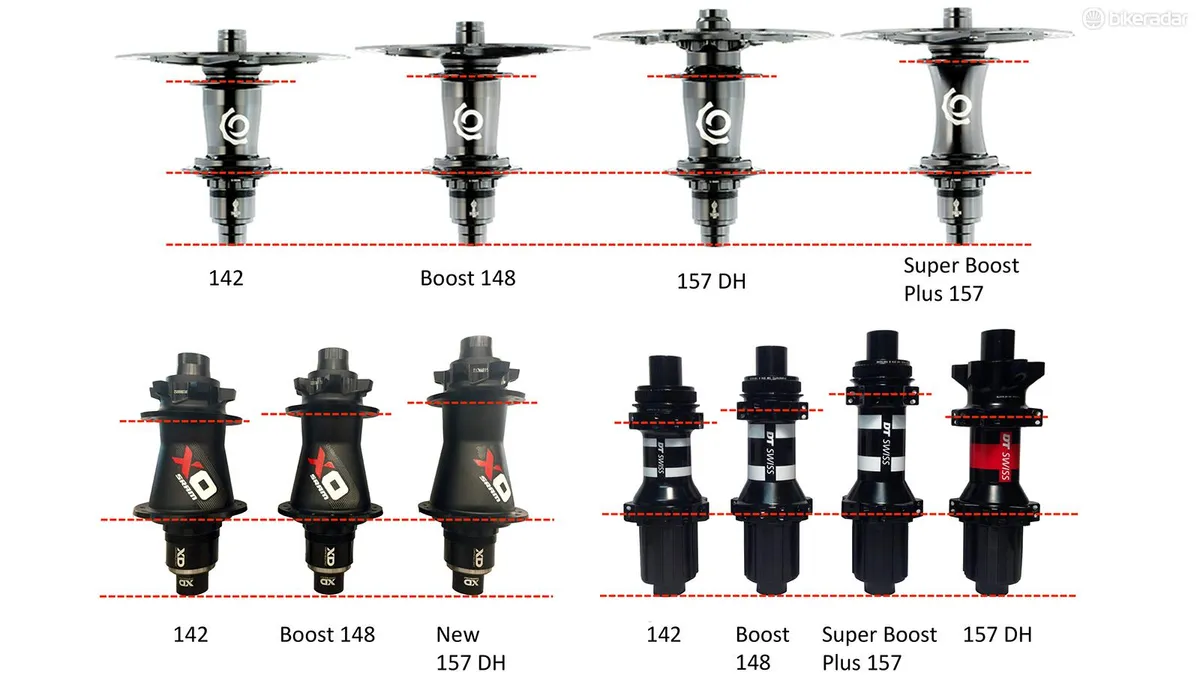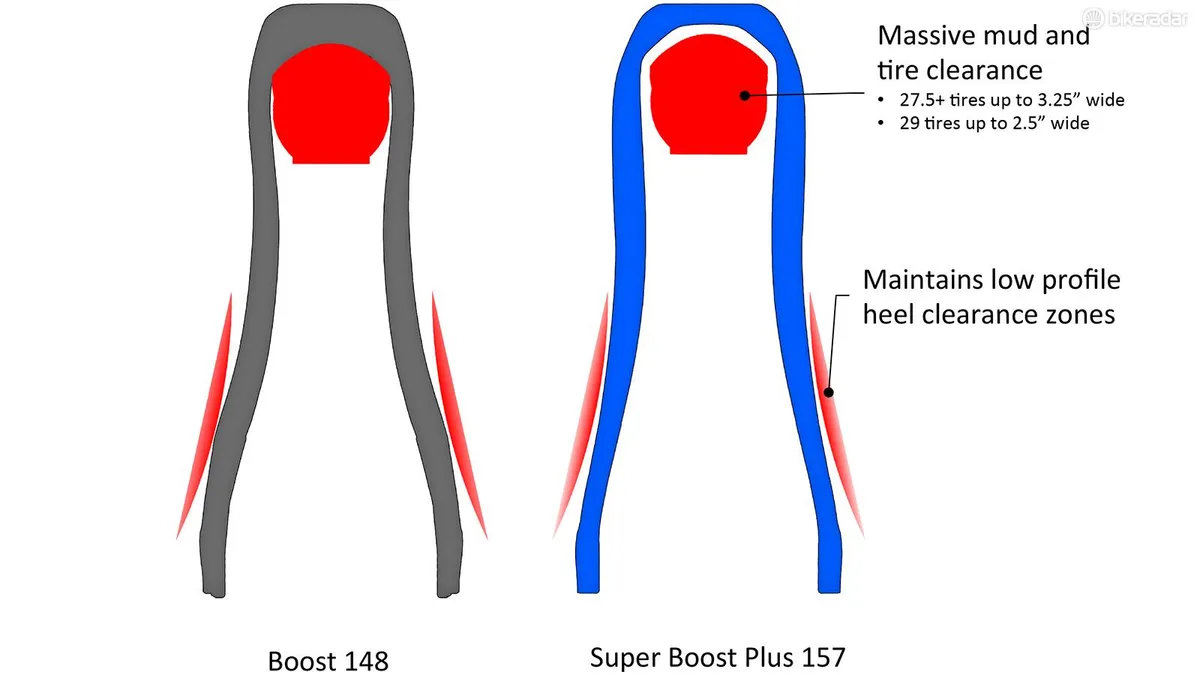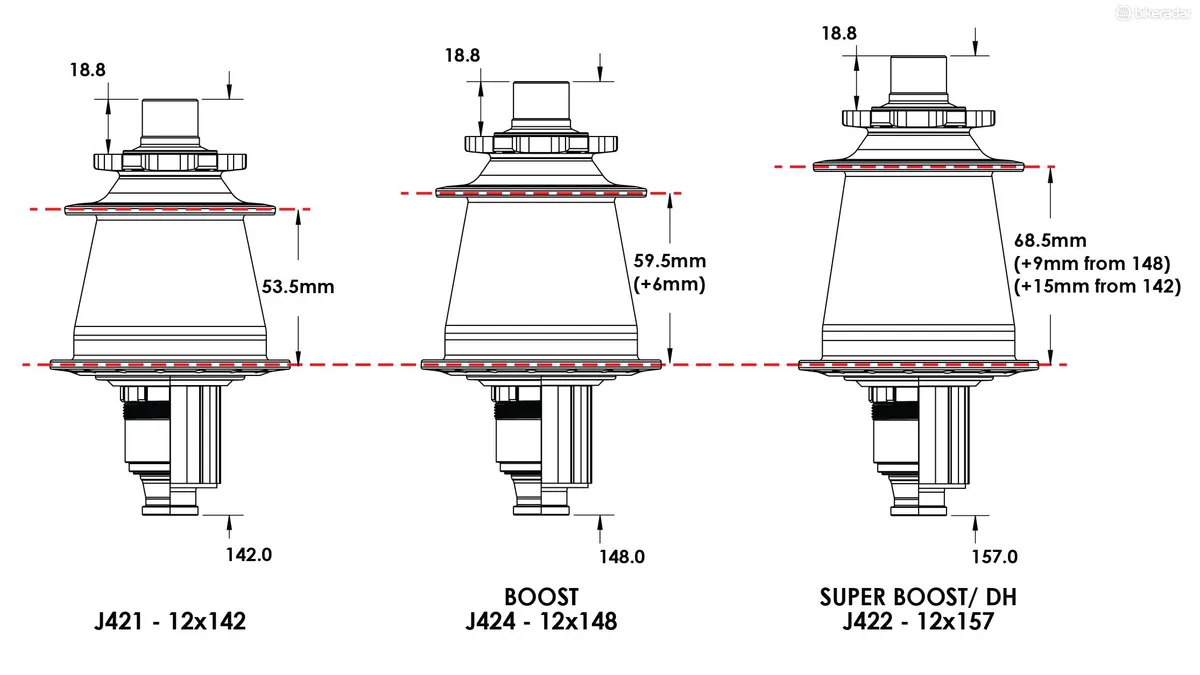For the last decade, change has been the only constant in mountain bikes. Evolutions in wheel and tire sizes, bottom-bracket systems, steerer-tube diameters, brake systems and axle configurations have all brought benefits and frustrations in equal measure.
The latest standard switch-up looming on the horizon is the so-called 'Super Boost' rear-axle spacing. I contacted seven industry experts to get their take on where Super Boost is headed.
- Over to you: are you tired of keeping up with the pace of change in cycling tech?
- A guide to mountain bike axle standards
- Knolly goes all in with new rear axle width "standard"

This Super Boost rear-axle standard isn’t completely new – hubs with 157x12mm axle spacing have existed for years on downhill bikes.
The difference is the majority of those hubs used the same flange spacing as 135x10 quick-release and 142x12mm thru-axle hubs. The new generation of Super Boost hubs share the same 157mm axle spacing but have hub flanges that are wider than today’s 148x12mm rear hubs, giving the spokes a wider bracing angle, leading to stronger rear wheels.
Other claimed benefits of the Super Boost standard include no change in the q-factor of cranksets and more tire clearance with less chance of heel rub on the chainstays.

Pivot Cycles adopted this new take on an existing axle standard when it unveiled the Switchblade in the summer of 2016. Since then, hub companies have joined to support it, but bike manufacturers have been slow to follow suit. Until now, it seems.
The small Canadian brand Knolly recently announced it was adopting this standard for all of its mountain bikes. Race Face followed suit, revealing that its Vault hubs will be offered in 157x12mm spacing. Race Face joins SRAM, Industry Nine, DT Swiss and others in offering Super Boost hubs.

This raises two key questions for mountain bikers pondering a new bike purchase. Will Super Boost go mainstream? And if so, will this become the new normal for mountain bikes?
Race Face / Easton: more Super Boost bikes coming to market soon
“This is a very hot topic right now," said Craig Ritchey, marketing manager at Race Face / Easton.
"A number of our OE partners and sponsored teams are testing 157x12mm Race Face wheels. Feedback has been very positive, this would suggest that we should expect further adoption of ‘Super Boost’ rear hub spacing by at least a couple more brands on one or more bike models in the next year. Will it become the new normal for mountain bikes? That question is harder to answer.”
Pivot Cycles: makes sense for some mountain bikes
“When we put this in motion, the idea was we would eventually get full support of the components companies," said Pivot president Chris Cocalis.
"The hub manufacturers were the quickest to adapt and now the crank and drivetrain manufacturers are coming on board. I don’t think this is the optimum standard for cross-country bikes but it does have applications across a wide range of trail bikes.
“I believe it is absolutely critical to go to 157 with the Super Boost chainline and hub configuration if a company wants to have a competitive product in the longer travel 29er category.
“As with most new things, it takes some time to make it into production across a wide range of bicycles. I think you will see it really take over the 29er trail bike category and we will see where it goes from there.”
Reynolds Wheels: stronger wheels for long-travel bikes
"We were one of the first wheel manufacturers to build 157x12 Super Boost wheels because of our OE partnership with Pivot, and we supplied them with special edition Blacklabel wheels for their premium spec builds when they introduced the spacing on their Switchblade," said Reynolds CEO Scott Montgomery.
"Looking forward, we think the Super Boost configuration will continue to gain momentum in some longer travel, aggressive riding focused bikes.
“The reality is a wider dropout will make for an even stronger wheel with better spoke bracing angles and more even tensions. It will improve durability in a category that is notoriously hard on wheels.
“I would not expect it to replace Boost spacing for 100–140mm travel bikes though as the added weight is a tradeoff for wheels that are generally durable enough for the average rider."
Trek Bikes: weighing the pros and cons
"We see merit in the Super Boost 157mm axle standard," said Ross Rushin, assistant MTB product marketing manager at Trek.
"It’s the logical evolution of the Boost148 standard that we had a hand in introducing three years ago. We’re aware of the benefits of Super Boost 157, but also the possible downsides, including heel strikes and consumer fatigue regarding new standards.
"With that in mind, we do not have plans to use the 157mm axle standard on any new bikes in 2019. As the market evolves, we are continuing to evaluate how it might benefit consumers, and where it might make sense to incorporate this standard into future bikes."
Giant Bicycles: still investigating
“We are prototyping it for DH applications as we speak, and seeing what we learn, and more importantly, gaining a better understanding of if there are more widespread application opportunities," said Kevin Dana, Giant's senior global off-road category manager.
"There's something there, but for us, it's really always about 'what problem are we trying to solve?'
"At a time when both consumers and dealers are struggling with constantly changing 'standards', it's important that Giant takes a scientific and factual approach that ultimately improves the ride and translates into more durability and more fun for the rider.”
Industry Nine: whatever comes next, we’re ready
“There is no way for us to tell who will be adopting this spacing," said Chris Reichel, marketing director at Industry Nine.
"Fortunately for us, we do all of our manufacturing in-house and we will be ready if/when more people want them.
“We don't know if it will be the new normal, but we have a feeling it will be around for a while.”
Stan’s Notubes: let’s pause and think about what riders really need
"Our hope is that if we all get to 157x12mm, we all stay there," said Chris Currie, creative director at Stan's.
"We should all be doing more to put the consumer first, and having four wheelsets in your garage that can't swap between bikes might not be improving the bike-ownership experience.
"Maybe there's a whole level of what people want out of bicycles that none of us have really figured out yet, but just based on my own experience, I wouldn't say 'convenience' is anywhere in our collective vocabulary. This might be a side-effect of our constant need to sell 10 bikes to one rider instead of bringing new riders into the equation."
What comes next?
The takeaway seems to be Super Boost is gaining momentum, but for now, at least, it’s not poised to take over every breed of mountain bike. Still, it begs the question, if companies are searching stiffness gains at the back of the bike, how seriously are they pondering a new axle standard for forks as well?
Let us know what you think of Super Boost in the comments section below.

